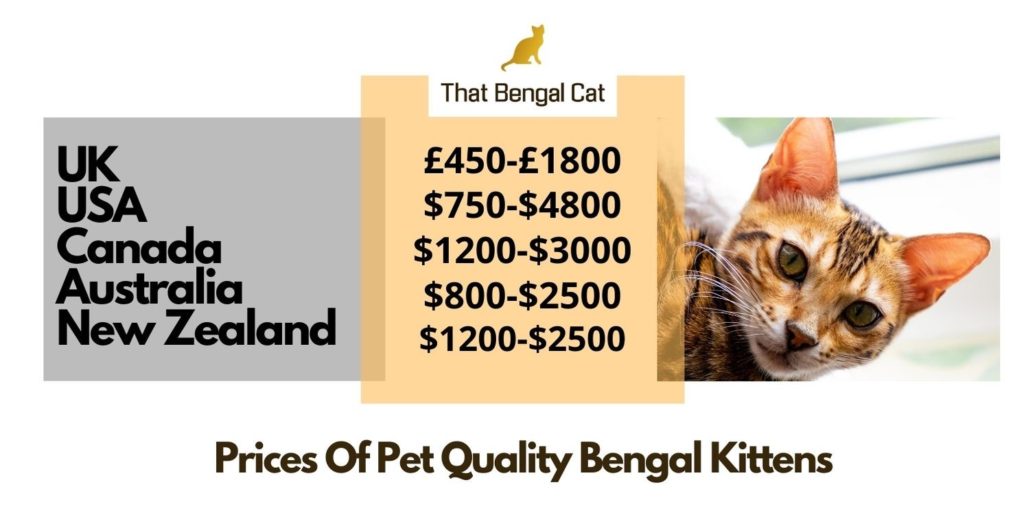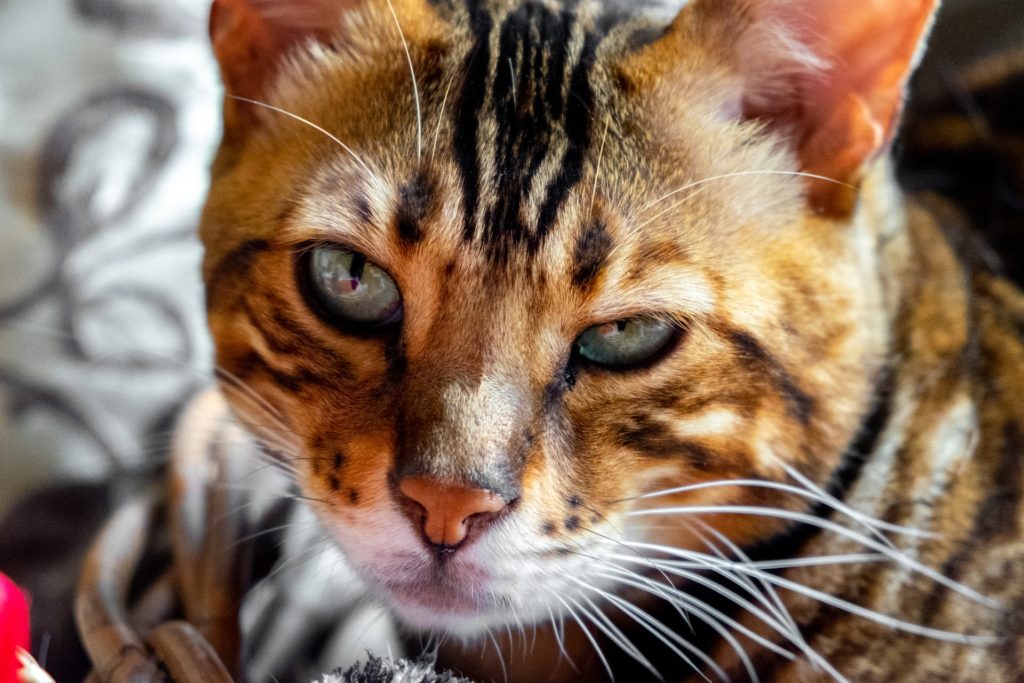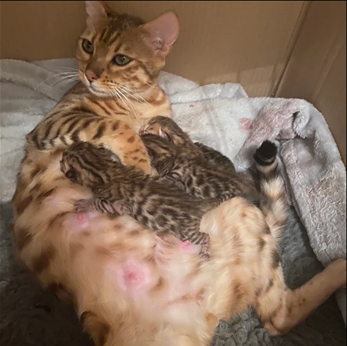This is THE most comprehensive guide on the prices of Bengal cats ever put together… probably.
Why?
Because it covers the cost of Bengal cats of all ages, colours and ‘quality’ with prices and advice direct from breeders from various parts of the world.
One of the first steps to owning any pet is determining whether you can afford it.
And not only that.
It’s whether the price you’re paying is fair and what you’re getting is genuine, healthy and happy.
So how much should you expect to pay and what should you look out for when buying a Bengal cat?
This in-depth, six part guide will answer those questions and more… questions.
To jump straight to the pricing graphic, click here
About The Author
This guide is the product of extensive research into how much a Bengal will cost to own and what factors determine a cat’s price.
I wanted to know as much as possible before purchasing my own and I discovered that there are numerous factors many may not be aware of that have a significant bearing on cost.
I’ve searched the internet, read articles and contacted breeders directly from all over the world, not only to provide information regarding cost, but also advice on what to look out for and what to avoid.
As this guide is aimed at those seriously thinking of owning a Bengal Cat I have asked questions many considering a Bengal, as at least a pet, may also ask.
Or perhaps, should.
Part 1: Factors That Affect Bengal Prices- Kitten Quality
The word ‘quality’ isn’t something you’d necessarily associate with cat cost- it has connotations linked to purchasing fabrics or say, wine.
But when it comes to prices of Bengal cats, ‘quality’ is a leading factor, and there are three levels as described below.
It’s important to note an individual kitten may be judged differently in terms of quality by different breeders.
Pet Quality: The most common, Pet Quality, simply means breeders are selling their kittens to be used as pets. There are numerous reasons for this and none have any bearing on the health of the cat.
For example, show cats must adhere to very stringent physical breed standards, therefore even minor derivations from this, perhaps with relation to the size of its tail, may put a kitten into the Pet Quality category, even though its tail is still perfectly functional and looks normal to those unfamiliar with show standards.
People like me.
Therefore, for most, a Pet Quality Bengal will be all that’s required.
Aside from older kittens and adult cats (more on these later), Pet Quality kittens fall into the most affordable category.
Current approximate Pet Quality kitten prices are shown in the graphic below:

Breed Quality: Kittens that represent the breed standard or display particular traits that would mix well with another cat’s traits (should they produce offspring of course) may be considered Breed Quality cats.
These Bengals will be sought after by those looking to, yes, breed their own.
Again, what is deemed a Breed Quality cat will vary, so if breeding Bengals is something you are considering it may be best to seek advice.
Many breeders will only sell Breed Quality kittens to other registered breeders so it’s important to check the rules and regulations regarding this in your own country or region.
In addition, the acquisition of ‘Breeding Rights’ needs to be considered, and these do not come cheap (see Price Summary Chart in Part 6).
Show Quality: These are cats that possess all the traits considered worthy of entering into a cat show.
This is also subjective and show trends (i.e. the traits that are being looked for) may change over time.
Not only are these cats more expensive but additionally, one must also pay for show/breeding rights.
In each of these groupings, the most affordable patterns appear to be ‘marbled’ Bengals with ‘snow’ and ‘silver’ cats the most expensive owing to their rarity.

Summary
The level of quality as deemed by each breeder/seller will be reflected in the price of the Bengal kitten.
There is a degree of subjectivity in this however.
Most people will be seeking Pet Quality Bengals, but for those interesting in breeding or showing, more research and expertise will be required as it’s important to adhere to the regulations of your particular region.
If you’ve decided on what sort of Bengal quality you want, one of the next things to consider when looking at prices of Bengal cats may surprise you a bit, as it seems gender and generation can play a role…
Part 2: Factors That Affect Bengal Prices- Gender and Generation
With Bengal cats, the generation number and also the cat’s gender impact on prices. This is due to sterility linked to the mixing of genes from two separate but closely related species, as I’ll explain.
Bengal cats are the product of breeding between the Asian Leopard Cat and the domesticated cat. In biology, the first generation of offspring is known as F1, with the second being F2 and so on.
F1 males, that is, male cats born from an Asian Leopard Cat and domesticated cat cross are invariably sterile and therefore functionless in terms of breeding. This may well remain true in male Bengals for a few generations- usually up to the 4th.
Because of this, an F1 male Bengal kitten may cost less, even though genetically (and visibly)), they may more closely resemble the Asian Leopard Cat.
Conversely, F1 females demand the highest of prices as these have the magical combination of being fertile (and therefore can be used for breeding) and bearing more Asian Leopard Cat traits.
In theory, half.
The majority of kittens however are what’s known as Stud Book Tradition (SBT), which are the product of a cross between a male and female Bengal.
These are typically 4 generations (or more) removed from the Asian Leopard Cat.
Summary
In general, generations close to the original cross will cost more than kittens derived from a Bengal to Bengal cat pairing.
An exception to this rule is likely to be early generation, sterile males, who are unable to breed and therefore may be sold as Pet Quality kittens.
The next factor to consider is perhaps more obvious and has implications for those starting to think a Bengal Cat might be out of their price range.
Part 3: Factors That Affect Bengal Prices- The Cat’s Age
Age is just a number, so the saying goes, and whether you believe that or not, when it comes to Bengal cats, age has implications for another number- namely the number of pounds or dollars you’ll need to spend.
From a breeder’s perspective, Bengal kittens are expensive to look after when considering both the money and time it requires to keep them happy and healthy.
Typically, kittens should be bought from 12 weeks old. Those that are younger may be cheaper, however there’s an increased risk of behavioural problems as they’ve not had the time to fully socially develop.
At the other end of the kitten scale, those that are on the brink of adulthood may also cost less.
That is in part due to demand- kittens are often appealing to buyers who want to be part of their pet’s life from a young age in order to witness them exploring and learning about the world.
This makes older kittens that may have passed through much of this stage less desirable and therefore as far as prices of Bengal cats go, less expensive.
Adult cats may be cheaper still.
Breeders are known to sell adults that once had the potential to reach show or breeder quality (but for whatever reason, didn’t quite make it) alongside those that are indeed are no longer used for reproduction.
With these cats, you may simply be charged for the cost of desexing and vaccinating.
As with Pet Quality Bengal kittens, these adults will still make good pets, although some may take longer to adjust to a new home than a kitten.

Adults could also be acquired via rescue shelters- for example, if an owner passes away, though finding one is likely to be a tough ask.
There could be some financial compensation owed to the rescue centre, but this is likely to be a fraction of what one would pay to a breeder.
Some rescue cats may require additional outlays particularly if little is known about the animal’s medical background or if there are issues that require long-term treatment.
Summary
Expect a Bengal kitten that falls within the 12-16 week age category to be the most expensive with adult rescue cats at the cheaper end.
Mature kittens should cost less, but avoid purchasing any on the opposite side of the kitten spectrum that have been weaned too early (those that are less than 12 weeks old).
Of course, a price of anything is set by the seller, so the next part discusses how and why a breeder may settle on a particular price point…
Part 4: Factors That Affect Bengal Prices- The Breeder
A good breeder should be looking to raise healthy, well-adjusted, sociable cats.
However, this takes time and money with expenditure being passed onto the buyer in the form of higher prices.
Breeders put Bengal kittens for sale at different price points based on what it’s taken them to raise their cats alongside their own personal situations and their subjective opinion as to what each is worth.
Healthcare is responsible for a huge chunk of a breeder’s outlay due to the cost of genetic testing and screening along with vaccinations and deworming treatments.

It would not be wrong to assume that significantly cheaper costing kittens may not have had the money spent on them in terms of healthcare.
If you’ve got a lot of cats, you’re going to need somewhere to keep them.
Many breeders may well have gone to the expense of buying or building a separate outdoor enclosure.
Lots of cats require lots of food, and some cats may have their diets tailored towards their own specific needs. Kittens will have different nutritional requirements to adults for example.
And good quality food usually costs more.
Cats registered with The International Cat Association (TICA) or a similar national variant incur the cost of registration (although this is only likely to be a nominal sum).
Additionally, there is the cost of breeding rights the breeder has had to pay in order to legally breed their Bengals.
Cheaper, unregistered kittens are therefore from owners who do not possess the legal requirements to be allowed to do this.
Location is important simply because the cost of everything needed to raise kittens may vary within regions of the same country.
If buying from further afield, some breeders with transport the kitten to you and some will even ship internationally, but obviously there will be additional charges for this.
Another reason why prices of Bengal cats are so high is that you’re paying for the amount of time the breeder has spent on the breeding program.
In effect, it’s a labour cost.
That’s because a breeder’s time is divided between the cats themselves, and the admin and necessities involved with running a business.

Raising animals doesn’t stop at 5pm with stories of dedicated breeders even sleeping on floors whilst their cats give birth.
In the US, a breeder told me it costs her over $1000 to raise a single kitten, with another estimating the figure being closer to $2000.
Summary
It should come as no surprise that breeders who spend money on and time with their cats are likely to charge more.
You can’t always guarantee someone who is charging more is actually looking after their animals well, but this is why you should ask and seek evidence, particularly with regards to registration, health and living environment.
It seems though, you get out what you put in.
A bit like doughnuts.
But please don’t eat a Bengal…
Of course, you’re going to want to look after your Bengal cat and continue the good work put in by the breeder.
So let’s take a look at the ongoing costs…
Part 5: Ongoing Costs
What’s true in terms of costs for Bengal breeders, is also true of Bengal pet owners, albeit on a smaller scale.
Your initial cost should include many of the things listed below.
However, if for whatever reason they are not incuded, then some of these will need to be factored in by you the buyer.
- The cost of vaccinations for the period up to the point of purchase (usually 12 weeks) is usually part of the purchase price. Any beyond this point will be paid for by you. Requirements differ in each country with rabies vaccine for example, not mandatory in the UK.
- Microchipping is something to strongly consider by Bengal owners who intend to let their cats out.
- Neutering or spaying is a minor procedure that will prevent your cat from having kittens in future- or giving other cats them. Some breeders will only give you a registration slip upon proof of desexing your animal.
- Insurance. Self-explanatory.
- Most cats usually require some kind of flea and worming treatment and Bengals are no different. These should be administered about once a month but may need to be adjusted based on the cat’s behaviour- if it hunts and kills prey for example.
- Litter is a recurring cost to be considered particularly if you intend to keep your Bengal indoors long-term.
- With Bengals accepted as a breed more towards the energetic end of the spectrum, house cats especially, will need a means or two to burn this excess energy off. Therefore expect to budget for toys– exercise and fun for both you and your cat.
- Accessories in terms of cat beds, feeding bowls and so on.
- It goes without saying, but I’ll still say it. Food. Breeders will often supply an initial small quantity of cat food and vouchers for discounts.
Summary
The cost of owning a pet clearly does not stop with the cost of the animal itself.
Prices of Bengal cats, which compared to many other breeds, are high anyway, but with the above factors taken into account will rise further, particularly if there are health problems and expensive trips to the vet.
Part 6: Prices of Bengal Cats Summary Chart
In order to improve the quality and accuracy of this article, I contacted a number of breeders from several countries.
The graphic below summarises the cost information I received from them and from the many websites used to research this topic.

Notes:
There is an overlap in prices between the groups due to the breeders own interpretation of value. This is particularly true of Show Quality and Breed Quality kittens.
Some breeders offer discounts for buying more than one kitten.
Breed Quality kittens may include the cost of breeding rights, though some breeders will only sell to others who are registered.
Prices of Bengal Cats: Conclusion
It probably became apparent very early on in this article, as it did to me whilst just beginning my research, that owning a Bengal cat is going to cost a fair bit of money, even for a ‘Pet Quality’ kitten.
Age, gender and how closely related a Bengal is to the Asian Leopard Cat impacts on price. Older kittens or adult cats, may be a better, more cost effective option for some.
Of course there could be occasions where breeders put their Bengal cats for sale at a lower than average price- returned kittens or genuine personal reason provided by a breeder.
In general it seems Bengal cat prices are high due to the efforts and expenditure of breeders.
You get what you pay for.
Having said that, you can only get a true sense of the conditions in which a cat has been raised in by visiting and seeing for yourself.
Ask as many questions as you feel is necessary to satisfy that the cat you’re getting has come from a good home.
Always factor in ongoing costs- or things like microchipping and neutering if they were not included in the original price.
It’s estimated that in the US, the cost of owning a cat will exceed $1000 in the first year.
Due to the subjective nature of assigning value to individuals it’s hard to fix on a specific market price, but this guide should give you a something to work from and providing you ask the right questions, help lead you to purchase your ideal feline companion.
Or cat, as I call them.
Further reading: Bengal Cat Scams: List of the 9 Top Things to Know to Avoid One.
Special thanks to the following breeders who helped with this article:
USA
Registered Bengals: Located between Portland, Oregon and Seattle, Washington, specialising in Brown Rosetted, TICA and CFA registered, purebred Bengal kittens.
Liberty Bengals: Active Duty Military Family owned Bengal Cattery focused on genetics and temperament for superior quality kittens.
Canada
Albedo Bengals: We have known and loved this breed for nearly 20 years will be here to help you every step of the way! We are located in Beautiful Williams Lake, British Columbia. We offer shipping and delivery services.
Australia
Atistaldi Bengals: “We are an in home, closed cattery located in the Hills District of Sydney. This means we keep a small number of breeding queens, and limited studs which we do not use to breed any cats but our own. We feel this way we can provide each cat, and future kittens the best and more intimate care. We are a proudly registered cattery with our local cat governing body of NSWCFA.”
New Zealand
Spotcom Bengal Cats: A small, registered cattery and the home of stunning brown, snow and silver Bengal cats. A breeder since 2014.
Amber Mountain: “Since 2007, Amber Mountain Bengals are registered with NZCF (The New Zealand Cat Fancy Association) and has imported the very best foundation breeders from top Australian/English/ and now Canadian lines for its unique Breeding programmes.”

![Prices of Bengal Cats: The Definitive Global(ish) Guide [2021]](https://thatbengalcat.com/wp-content/uploads/2020/10/bengal-cat-attentive-looking-1334991.jpg)